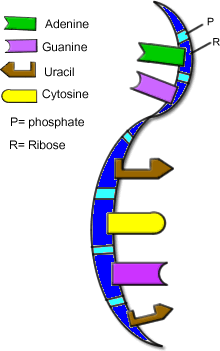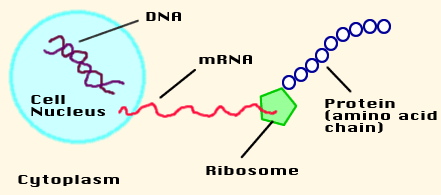|
|
|
|
| |
Deoxyribonucleic acid (DNA) is a nucleic acid that contains the genetic instructions used in the development and functioning of all known living organisms. The main role of DNA molecules is the long-term storage of information. DNA is often compared to a set of blueprints, since it contains the instructions needed to construct other components of cells, such as proteins and RNA molecules. The DNA segments that carry this genetic information are called genes, but other DNA sequences have structural purposes, or are involved in regulating the use of this genetic information.
Chemically, DNA is a long polymer of simple units called nucleotides, with a backbone made of sugars and phosphate groups joined by ester bonds. Attached to each sugar is one of four types of molecules called bases. It is the sequence of these four bases along the backbone that encodes information. This information is read using the genetic code, which specifies the sequence of the amino acids within proteins. The code is read by copying stretches of DNA into the related nucleic acid RNA, in a process called transcription.
Within cells, DNA is organized into structures called chromosomes. These chromosomes are duplicated before cells divide, in a process called DNA replication. Eukaryotic organisms such as animals, plants, and fungi store their DNA inside the cell nucleus, while in prokaryotes such as bacteria it is found in the cell's cytoplasm. Within the chromosomes, chromatin proteins such as histones compact and organize DNA. These compact structures guide the interactions between DNA and other proteins, helping control which parts of the DNA are transcribed.
--------------------------------------------------------------------------------------------
Deoksiribonükleik asit ya da kısaca DNA, tüm hücreli canlıların ve bazı virüslerin biyolojik gelişimleri için gerekli genetik bilgiyi taşıyan nükleik asittir.
DNA, canlının özelliklerinin soydan soya geçmesini sağladığı için bazen kalıtım molekülü olarak da adlandırılır.
Bakterilerde ve diğer basit hücreli canlılarda DNA hücrenin içinde dağınık biçimde bulunur. Hayvanları ve bitkileri oluşturan daha karmaşık hücrelerde ise DNA'nın çoğu hücre çekirdeğindeki kromozomlarda bulunur. Enerji üreten kloroplast ve mitokondri organellerinde ve pek çok virüste de bir miktar DNA bulunur.
Konu başlıkları
[gizle]
* 1 Moleküler yapı
* 2 Nükleotit dizisinin önemi
* 3 DNA ikileşmesi
* 4 Ayrıca bakınız
* 5 Dış Bağlantılar
Moleküler yapı
Bazen "kalıtım molekülü" olarak adlandırılsa da, DNA aslında tek bir molekül değil, bir çift moleküldür. Bu çift molekül, bir sarmaşığın dalları gibi birbiri çevresinde dönerek bir sarmal oluştururlar.çağdaş bir yapıya sahiptirler.1,5-2 m kadar boyu vardır.
Nükleotit dizisinin önemi
Bir gen içerisinde DNA ipliği üzerindeki nükleotid dizisi her canlının yaşamı boyunca üretmek ve "ifade etmek" zorunda olduğu proteinleri tanımlar. Nükleotit dizisi ile proteinlerdeki amino asit dizisi arasındaki ilişki basit çeviri kurallarıyla belirlenir, bu kurallara topluca genetik kod adı verilir. Genetik kod, kodon denilen, üç nükleotitden oluşan, üç harfli 'kelimeler'den meydana gelir (Örneğin ACT, CAG, TTT). Bu kodonlar haberci RNA (mRNA) ve taşıyıcı RNA (tRNA) aracılığıyla ribozomlarda her kodon bir amino aside denk gelmek üzere proteinlere çevrilirler. 64 değişik kodon olasılığı ve sadece 20 değişik amino asit olduğundan birçok amino asidin birden fazla belirtici kodonu vardır. DNA üzerindeki nükleotitler mRNA ve daha sonra tRNA üzerine kopyalanırken timin nükleotidi (T) urasil (U) ile değiştirilir. Ayrıca protein sentezinin başlangıcını belirten bir başlatma kodonu (AUG, metionin amino asidini kodlar) ile bitimini belirten üç olası bitiş kodonu (UAA, UAG ve UGA) bulunur.
DNA ikileşmesi
DNA ikileşmesi
DNA ikileşmesi ya da DNA sentezi, hücre bölünmesi öncesinde çift sarmallı DNA'nın kopyalanması işlemidir. Kopyalanan yeni DNA iplikleri hemen hemen tamamen aynıdır, ancak zaman zaman çoğalmadaki hatalar nedeniyle kopyalama mükemmel olmaz (bkz. mutasyon), ve sonuçtaki her iki sarmal da bir eski ve bir yeni iplikten oluşur. Buna yarı korunumlu çoğalma denir. DNA'nın çoğalması işlemi üç adımdan oluşur: başlatma, ikileşme ve sonlandırma.
-----------------------------------------------------------------------------------------
|

DNA - DEOXYRIBONUCLEIC ACID
DNA is sometimes called "the blueprint of life" because it contains the code, or instructions for building and organism and ensuring that organism ********s correctly. Just like a builder uses a blueprint to build a house, DNA is used as the blueprint, or plans, for the entire organism.
It is the chemical component of chromosomes, which are located in the nucleus of every cell. Stretches of DNA (or stretches of chromosomes) code for genes.
Gene - a segment of DNA that codes for a protein, which in turn codes for a trait (skin tone, eye color..etc), a gene is a stretch of DNA.
The structure of DNA was established by James Watson and Francis Crick.
The shape of the DNA molecule is a double-helix (like a twisted ladder). The sides of the ladder are composed of alternating sugars (deoxyribose) and phosphates. The rungs of the ladder are composed of nucleotides.
Nucleotides (also called Bases)
Adenine, Thymine, , Guanine, Cytosine or A, T, G, C
Nucleotides pair in a specific way - called the Base-Pair Rule
Adenine pairs to Thymine
Guanine pairs to Cytosine
Memory helper - think "A T Granite City") - which is where you live
The rungs of the ladder can occur in any order (as long as the base-pair rule is followed)
For instance, a stretch of DNA could be AATGACCAT - which would code for a different gene than a stretch that read: GGGCCATAG. All in all, there are billions of bases (nucleotides) in cells, which code for all the things an organism needs to ********.
DNA REPLICATION
Replication is the process where DNA makes a copy of itself. Why does DNA need to copy? Simple: Cells divide for an organism to grow or reproduce, every new cell needs a copy of the DNA or instructions to know how to be a cell. DNA replicates right before a cell divides.
DNA replication is semi-conservative. That means that when it makes a copy, one half of the old strand is always kept in the new strand. This helps reduce the number of copy errors.
RNA
DNA remains in the nucleus, but in order for it to get its instructions translated into proteins, it must send its message to the ribosomes, where proteins are made. The chemical used to carry this message is Messenger RNA
 RNA = ribonucleic acid. RNA = ribonucleic acid.
RNA is similar to DNA except:
1. has on strand instead of two strands.
2. has uracil instead of thymine
3. has ribose instead of deoxyribose
mRNA has the job of taking the message from the DNA to the nucleus to the ribosomes.
Tran******ion - RNA is made from DNA
Translation - Proteins are made from the message on the RNA

|
| |
DNA - DEOXYRIBONUCLEIC ACID
|
|
DNA is sometimes called "the blueprint of life" because it contains the code, or instructions for building and organism and ensuring that organism ********s correctly. Just like a builder uses a blueprint to build a house, DNA is used as the blueprint, or plans, for the entire organism.
It is the chemical component of chromosomes, which are located in the nucleus of every cell. Stretches of DNA (or stretches of chromosomes) code for genes.
Gene - a segment of DNA that codes for a protein, which in turn codes for a trait (skin tone, eye color..etc), a gene is a stretch of DNA.
The structure of DNA was established by James Watson and Francis Crick.

The shape of the DNA molecule is a double-helix (like a twisted ladder). The sides of the ladder are composed of alternating sugars (deoxyribose) and phosphates. The rungs of the ladder are composed of nucleotides.
Nucleotides (also called Bases)
Adenine, Thymine, , Guanine, Cytosine or A, T, G, C
Nucleotides pair in a specific way - called the Base-Pair Rule
Adenine pairs to Thymine
Guanine pairs to Cytosine
Memory helper - think "A T Granite City") - which is where you live
The rungs of the ladder can occur in any order (as long as the base-pair rule is followed)
For instance, a stretch of DNA could be AATGACCAT - which would code for a different gene than a stretch that read: GGGCCATAG. All in all, there are billions of bases (nucleotides) in cells, which code for all the things an organism needs to ********.
DNA REPLICATION
Replication is the process where DNA makes a copy of itself. Why does DNA need to copy? Simple: Cells divide for an organism to grow or reproduce, every new cell needs a copy of the DNA or instructions to know how to be a cell. DNA replicates right before a cell divides.
DNA replication is semi-conservative. That means that when it makes a copy, one half of the old strand is always kept in the new strand. This helps reduce the number of copy errors.

RNA
DNA remains in the nucleus, but in order for it to get its instructions translated into proteins, it must send its message to the ribosomes, where proteins are made. The chemical used to carry this message is Messenger RNA
 RNA = ribonucleic acid. RNA = ribonucleic acid.
RNA is similar to DNA except:
1. has on strand instead of two strands.
2. has uracil instead of thymine
3. has ribose instead of deoxyribose
mRNA has the job of taking the message from the DNA to the nucleus to the ribosomes.
Tran******ion - RNA is made from DNA
Translation - Proteins are made from the message on the RNA

|
| |
Chapter 8: The Structure of DNA, RNA and Proteins
|
|
This chapter will explore the structure of nucleic acids and proteins.
DNA Structure
DNA is composed of several different subunits. The backbone of the molecule is made of a sugar called deoxyribose. The deoxyribose is held together by phosphate groups. Deoxyribose also forms bonds with the four bases, adenine (A), cytosine ( C), thymine (T) and guanine (G). Figures 8.1-8.6 depict how the subunits are assembled in a DNA molecule. In these figures, black represents adenine, white thymine, dark gray guanine, and light gray cytosine.
Figure 8.1: Rasmol Image of DNA Double Helix Segment

Figure 8.2: Closer View of DNA

Figure 8.3: Conceptual DNA Model

Figure 8.4: Top and Side view of Two Steps


Chapter 3 describes how this structure stores information. The order of the four bases (A, T, C and G) read three at a time per table 3.2 determine the amino acid sequence in the final protein.
|
|
|
|
|
|
|
| |
Bugün 1 ziyaretçi (1 klik) kişi burdaydı! |
|
|
|
|
|
|
|